
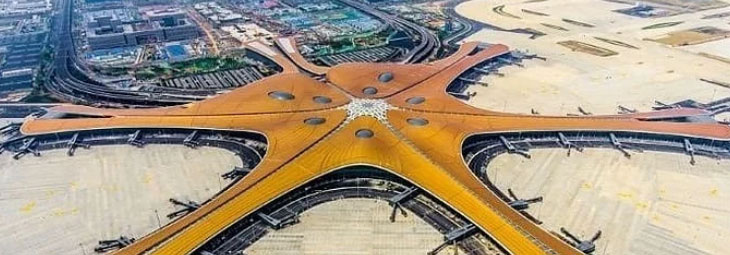
I. Introduction to the Greater Bay Area
The construction of the Guangdong-Hong Kong-Macao Greater Bay Area (the GBA) is a national-level strategy proposed and implemented by Chinese President Xi Jinping. It's a move to provide a new model of comprehensive opening up and also a new practice of 'One Country, Two Systems'.
The GBA consists of the Hong Kong SAR, Macao SAR, and nine cities in Guangdong (namely Guangzhou, Shenzhen, Zhuhai, Foshan, Huizhou, Dongguan, Zhongshan, Jiangmen and Zhaoqing) with a total area of 56,000 square kilometers. By the end of 2020, the region's population had reached over 80 million. It is one of the regions with high openness, strong economy and strategic importance in China (Fig. 1).
Featuring regional advantages, strong economy, innovation power and advanced engagement with international businesses, the GBA will become a dynamic world-class city cluster, a global technology and innovation hub, a key component of Belt and Road initiative, a showcase for in-depth cooperation between the Chinese mainland, Hong Kong and Macao, as well as an ideal place for living, working and traveling.
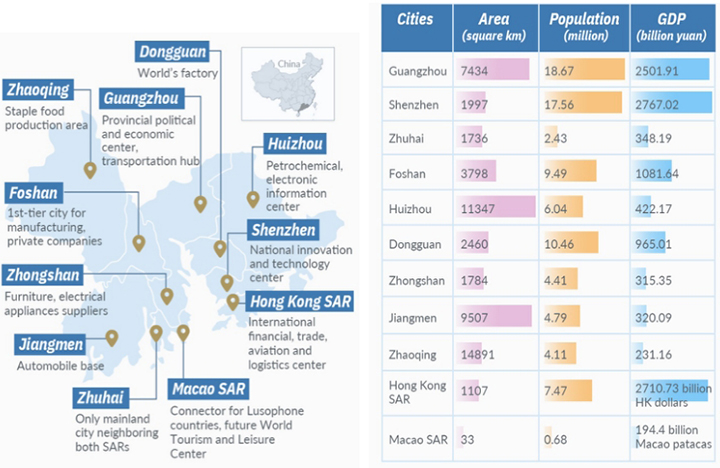
Fig. 1 the Map and Major Statistics of GBA Cities [Source: newsgd.com]
2. Outline Development Plan for the Greater Bay Area
Chinese authorities unveiled the outline development plan for the Greater Bay Area on Feb 18, 2019 aiming to develop the region into “a role model of high-quality development.”
The plan was released by the Central Committee of the Communist Party of China and the State Council.
The plan covers the period from 2019 to 2022 in the immediate term and extends to 2035 in the long term. The plan has 11 chapters: the background, the overall requirements, the spatial layout, developing an international innovation and technology hub, expediting infrastructural connectivity, building a globally competitive modern industrial system, taking forward ecological conservation, developing a quality living circle for living, working and traveling, strengthening cooperation and jointly participating in the Belt and Road Initiative, jointly developing Guangdong-Hong Kong-Macao cooperation platforms, and the implementation of the plan.
The plan says the bay area will be turned into a vibrant world-class city cluster, a globally influential international innovation and technology hub, an important support pillar for the Belt and Road Initiative, a showcase for in-depth cooperation between the mainland and Hong Kong and Macao, and a quality living circle for living, working and traveling.
Efforts should be made to build on the four core cities of Hong Kong, Macao, Guangzhou and Shenzhen as core engines for regional development, continue leveraging their comparative advantages in striving for excellence and achievements, and strengthen the radiating effect in leading the development of nearby regions.
Setting development objectives, the plan says by 2022 the framework should essentially be formed for an international first-class bay area and world-class city cluster that is vibrant and highly innovative with an optimized industrial structure, a smooth flow of various factors and a pleasant ecological environment.
By 2035, the bay area should have an economic system and a mode of development mainly supported by innovation, with its economic and technological strengths vastly increased and its international competitiveness and influence further strengthened, it adds.
The people should become wealthier; the level of social civility should reach new heights, with cultural soft power demonstrably strengthened, Chinese cultural influence broadened and deepened, and exchange and integration between different cultures further enhanced, the plan says.
Meanwhile, the levels of conservation and efficient use of resources should be significantly improved, the ecological environment should be effectively protected, and an international first-class bay area for living, working and traveling should be fully developed.
3. the Development of GBA in Recent Years
GBA saw high quality developments in the past five years, with optimized collaboration for innovation, new system for open economy and better infrastructures.
In 2021, GBA's GDP reached 12.6 trillion RMB, up 2.4 trillion compared with year 2017. The area is now home to 25 Fortune Global 500 enterprises, with 8 new comers in five years. Here are more highlights about GBA in the past few years.
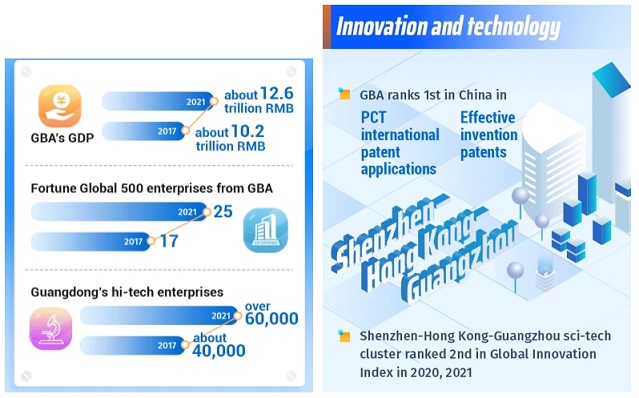
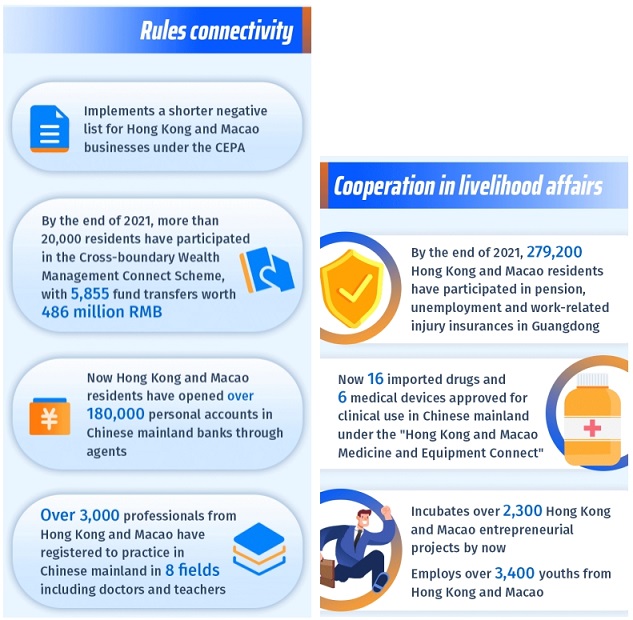
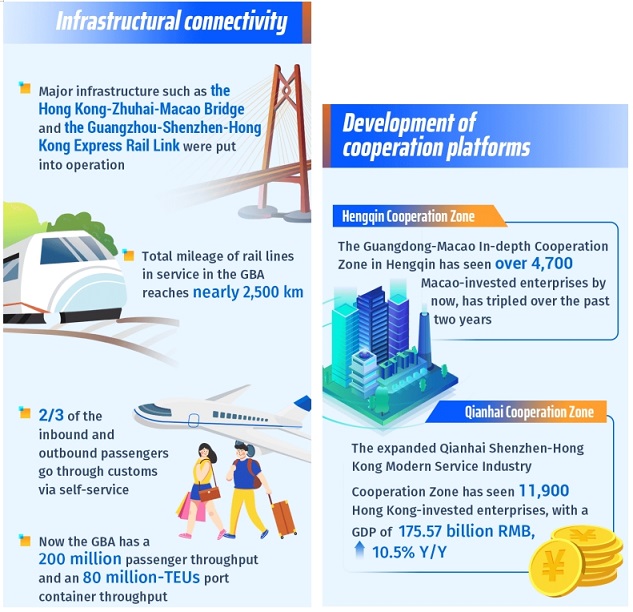
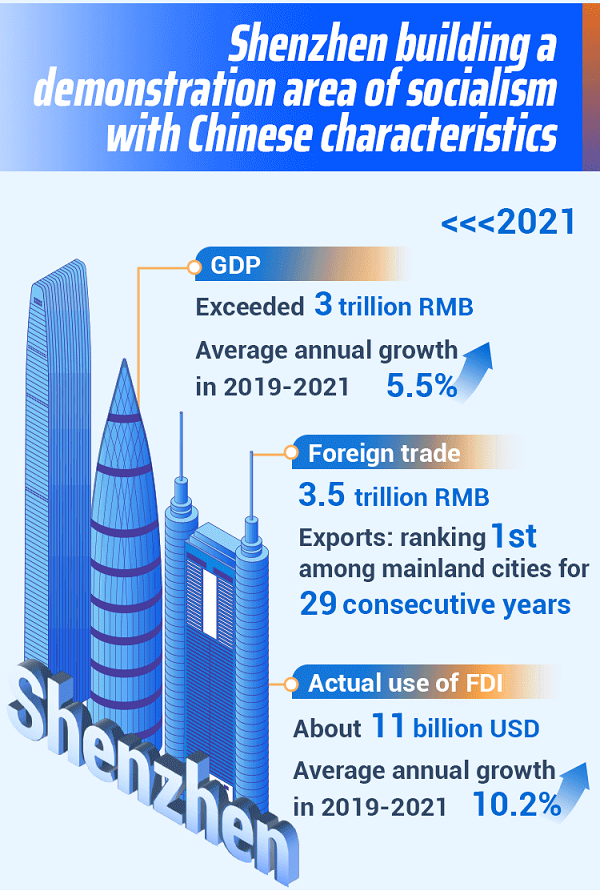
Fig. 2 Infographics of GBA in the Past Few Years [Source: newsgd.com]
In 2022, the GDP of GBA exceeded 13 trillion RMB, according to the statistics authorities of the GBA. The GDP of nine mainland cities of GBA surpassed 10.46 trillion RMB, while that of Hong Kong SAR and Macao SAR registered about 2.83 trillion HKD (2.43 trillion RMB at 2022 average exchange rate) and 177.3 billion MOP (1.47 trillion RMB at 2022 average exchange rate) respectively.
Furthermore, the total foreign trade of the GBA reached 2.5 trillion USD in 2022, accounting for 5 percent of the global total, according to the latest statistics from the General Administration of Customs of the People’s Republic of China (GACC).
In 2023, Guangdong has set the GDP growth by more than 5 percent, and the government of Hong Kong forecasts economic growth of 3.5 percent to 5.5 percent this year.
Source:
<https://www.cnbayarea.org.cn/english/About%20GBA/content/post_165618.html>
<https://english.www.gov.cn/policies/latest_releases/2019/02/18/content_281476527605892.htm>
<https://www.cnbayarea.org.cn/english/Specials/infographics/content/post_975409.html>
<https://www.newsgd.com/node_8a3c5cb3c2/8455d58611.shtml>
Edited by Bao Lianying